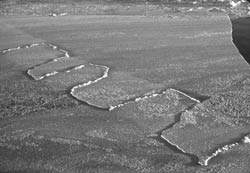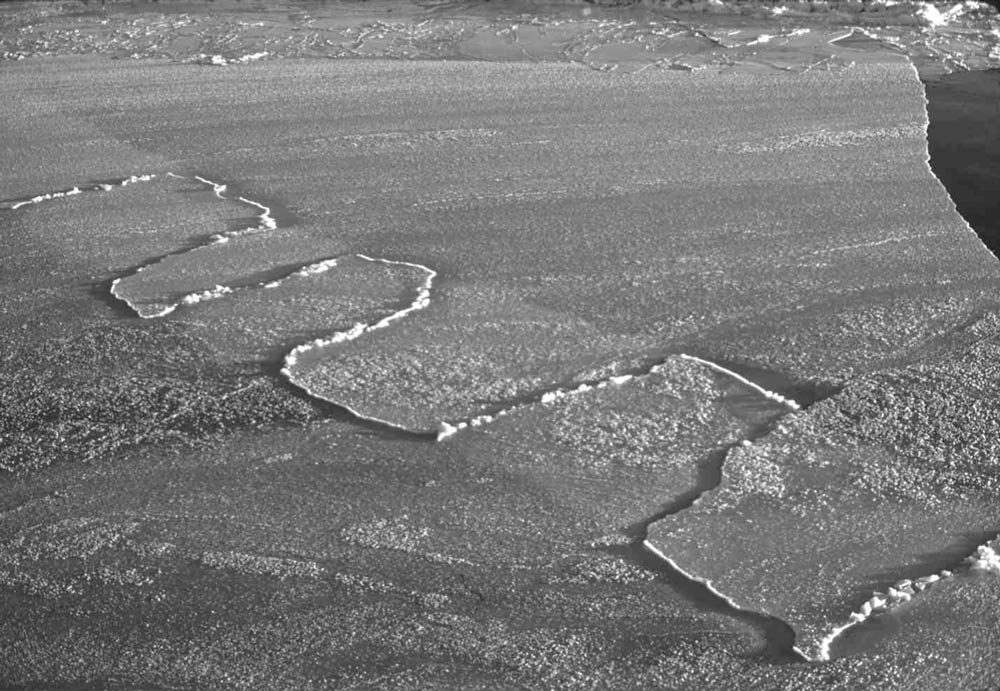Cold Fingers
For more than half a century, scientists and polar explorers have puzzled over the origin of serrated zipper-like patterns that sometimes form when floating ice sheets collide. In the 23 February Physical Review Letters, physicists give the first theoretical explanation for these formations. The same mechanism may have a role in shaping the boundaries of tectonic plates, the researchers suggest, and might be used to create structures as small as the gears of a nanomachine.
When two ice sheets driven by wind and ocean currents collide, one will often ride up over the other. But occasionally the edges of the sheets mesh together in an arrangement of interlacing, roughly rectangular protrusions a meter or so wide. This phenomenon, called finger rafting, occurs only if the ice sheets are less than about 10 centimeters thick. Both sheets, moreover, must have the same thickness–which can happen when a single ice sheet breaks up and fragments of it later collide. Since the pattern wasn’t noticed anywhere else in nature, most physicists simply chalked it up to some peculiarity in the properties of ice.
In devising a theory of finger rafting, however, John Wettlaufer of Yale University and Dominic Vella of Cambridge University in England conclude that the phenomenon can occur for any material with the right properties. To prove the point, they created similar patterns by gently forcing together thin layers of sealing wax floating on water.
Thin sheets, whether of ice or wax, often have naturally ragged edges. At first contact between two sheets, Wettlaufer and Vella argue, a protuberance on one will nudge either under or over the other. Because the floating sheets are slightly flexible, each responds by developing a series of ripples or corrugations spreading out from the initial point of disturbance. It’s something like what happens as you haul yourself onto a wide air mattress in a swimming pool: the sections next to you rise up as you pull down, and sections beyond them slump down again.
If the colliding sheets are equally thick, their ripples have the same wavelength, according to Wettlaufer and Vella’s theory. They also have opposite phase–where one sheet rises up, the other sags down–because the sheets bent in opposite directions at the point of contact. As the corrugated sheets press together, fractures running roughly perpendicular to the edge set in at the points of direct contact. The “fingers” of material between the fractures then push over and under each other and create the zipper-like pattern.
To test their theory, the physicists found a sealing wax with a combination of flexibility and “tearability” that made it a good mimic for ice. Carefully floating wax layers a few hundred microns thick in a tub of water, they observed finger rafting when the sheets collided. Wettlaufer and Vella measured finger widths for several wax thicknesses, and their data agreed with the theory’s predictions. The predictions also agreed with observations of finger rafting of real ice sheets.
The new work “is a lovely demonstration that brings together experiment and theory to explain a puzzling observation, and shows that simple mechanical systems often yield surprising results,” says physicist Michael Marder of the University of Texas in Austin.
Wettlaufer and Vella think their theory may be useful in plate tectonics, where some geophysicists say they can find continent-scale examples of finger rafting. On very small scales, Wettlaufer says, engineers may be able to design self-assembling nanostructures like gear teeth by pressing together two suitable materials. Most intriguingly, he adds, planned space missions to Jupiter’s ice-clad moon Europa may discover finger rafting on a planetary scale.
–Jonathan Sherwood
Jonathan Sherwood is a senior science writer at the University of Rochester, New York.
More Information
Floating Ice Group at the University of Alaska, Fairbanks





